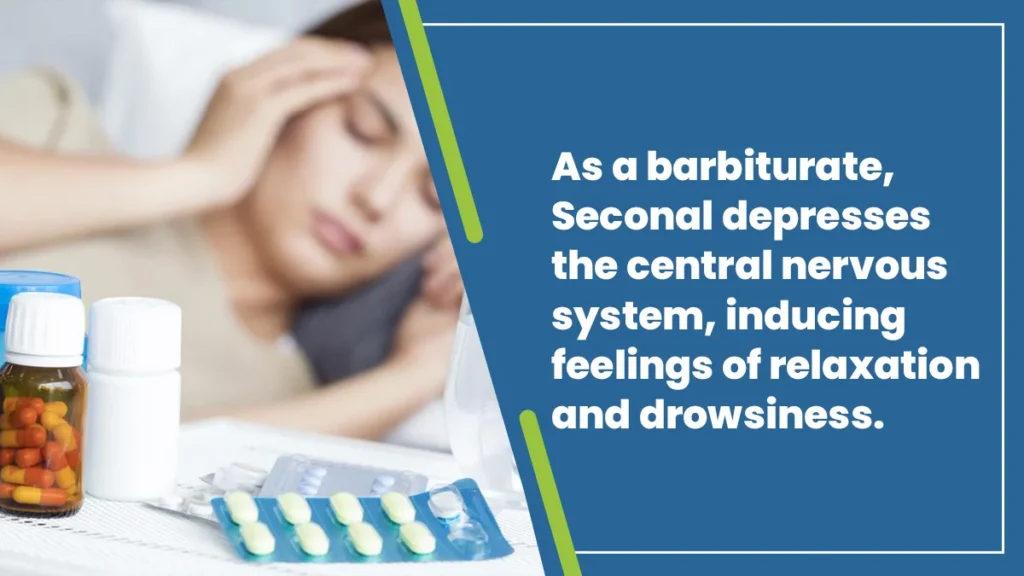Seconal is a prescription medication primarily used to treat insomnia. Seconal addiction is marked by tolerance, dependence, and withdrawal symptoms. Its calming effects make it appealing for recreational use.
While Seconal offers significant therapeutic benefits, it also poses a severe risk of addiction and dependence. Delve deeper to explore the dangers of Seconal dependency, its treatment options, and preventions for Seconal addiction.
Key Takeaways
Seconal addiction is marked by a dependency on the drug for sleep, relaxation, and its calming effects. Here is what this article covers:
- As a barbiturate, Seconal depresses the central nervous system, inducing feelings of relaxation and drowsiness.
- Seconal overdose can be fatal, highlighting the urgent need for awareness and medical treatment.
- Treatment for Seconal addiction typically involves a combination of medication, therapy, and support groups.
- Empower your recovery drive with The Haven Detox-New Jersey by calling (856) 565-3102 for inclusive support and treatment information.

Introduction To Seconal Addiction
Seconal, a brand name for secobarbital, is a sedative-hypnotic medication prescribed for short-term treatment of insomnia. It belongs to a class of drugs called barbiturates that function as a central nervous system depressant, inducing relaxation and sleepiness.
First introduced in the early 1900s, Seconal quickly gained popularity due to its effectiveness in treating sleep disorders. However, its potential for addiction and abuse soon became evident. Secobarbital addiction poses serious health risks, including respiratory depression, overdose, and death.
Prolonged use or misuse can lead to physical and psychological reliance on the drug. Over time, individuals may develop tolerance, requiring higher doses to achieve the desired effects. Withdrawal from Seconal can be challenging and potentially life-threatening, requiring medical attention and support.
Causes Of Seconal Addiction
Seconal addiction can arise due to various reasons, often linked to its potent sedative effects. Understanding these causes helps in addressing the issue effectively. Here are the details:
Medical Reasons
Seconal, a barbiturate, is prescribed for insomnia and anxiety relief. Long-term use can lead to physical dependency on the drug as the body adapts to its effects. Drug dependence makes it difficult to discontinue without experiencing withdrawal symptoms.
Recreational Use
Some individuals misuse secobarbital for its euphoric effects, seeking relaxation and a sense of well-being. This recreational drug often leads to higher doses and frequent consumption, significantly increasing the risk of addiction.
Risk Factors
Genetic predisposition, mental illnesses, and environmental factors, for example, stress or exposure to drug abuse, can increase the risk of addiction. These factors may make persons more vulnerable to developing dependence on the drug.
Addressing Seconal addiction requires a proper understanding of its causes, enabling more effective prevention and treatment strategies.
Symptoms Of Seconal Addiction
Seconal addiction involves a range of symptoms that affect individuals physically, psychologically, and behaviorally. Here are the details:
Physical Symptoms
Identifying physical signs of Seconal addiction can help in diagnosing and addressing the problem early.
- Drowsiness and lethargy
- Slurred speech
- Nausea and vomiting
- High blood pressure
- Respiratory depression
- Life-threatening withdrawal symptoms such as tremors and seizures
- Early detection of physical signs can improve outcomes and assist people to regain control over their lives.
Psychological Symptoms
Psychological symptoms are crucial indicators of Seconal addiction and can significantly impact mental health.
- Confusion and memory loss
- Anxiety and depression
- Mood swings or emotional instability
- Paranoia
- Hallucinations
- Decline in brain function
- Timely intervention can prevent further psychological decline and support recovery.
Behavioral Symptoms
Behavioral changes often provide visible signs of secobarbital addiction, highlighting the need for intervention.
- Doctor shopping to obtain more prescriptions
- Social withdrawal and isolation
- Neglecting responsibilities at work or home
- Engaging in risky behaviors
- Craving and compulsive drug-seeking
Recognizing these behavioral signs of addiction is vital for diagnosing Seconal addiction, as they significantly impact an individual’s quality of life.
Diagnosis Of Seconal Addiction
Seconal addiction is a serious condition that requires careful evaluation for proper treatment. The diagnosis can be approached in various ways:
Self-Diagnosis
Self-diagnosis involves individuals recognizing symptoms of Seconal addiction in themselves. It includes increased tolerance, unpleasant withdrawal symptoms, and an uncontrollable urge to use the drug. While self-awareness is important, self-diagnosis is often limited and can miss underlying issues, necessitating professional help.
Professional Diagnosis
Professional diagnosis is conducted by healthcare providers who assess substance abuse through medical history, physical exam, and psychological evaluations. It identifies both the addiction and any co-occurring mental illness, allowing for an effective treatment plan.
Diagnostic Criteria And Tools
Diagnosis relies on established criteria such as those outlined in the DSM-5 for substance use disorders. Tools like standardized questionnaires, urine tests, and interviews aid in assessing the cravings, withdrawal symptoms, and the dose of barbiturates with daily functioning.
Diagnosing barbiturate addiction involves a combination of tools, ultimately aiding in the understanding and management of this substance use disorder (SUD).
Impact Of Seconal Addiction
The misuse of Seconal has broad consequences that extend beyond individual health concerns. Here’s what’s of significance:
Health Consequences
Seconal addiction can lead to severe health issues, including respiratory depression, cardiovascular problems, and even coma or death in severe cases. Long-term abuse may result in liver damage, cognitive impairment, and a high risk of mental health issues such as depression or anxiety. Extended use can also lead to tolerance and physical dependence, exacerbating the cycle of addiction.
Social Consequences
Addiction to secobarbital can fracture social relationships and undermine personal connections. Individuals may withdraw from family and friends, listing drug use over meaningful interactions. Employment stability is compromised, leading to financial stress and potential unemployment.
Therefore, to lessen the common side effects of barbiturate addiction, we need everyone to participate, both on an individual and community level.
Treatment Options For Seconal Addiction
Seconal addiction can be a challenging condition to overcome, but there are potent treatment options available to help people reclaim their lives. Some treatment options are:
Medical Detoxification
The medical detox process involves safely managing withdrawal symptoms under medical supervision. It typically occurs in a specialized facility where medical professionals monitor the individual’s physical and psychological condition. They ensure a safe and comfortable detoxification experience for patients who have an addiction.
Behavioral Therapy
Behavioral therapy aims to address the underlying reasons for substance abuse and prevent relapse. Therapies such as cognitive behavioral therapy (CBT) and motivational interviewing (MI) are common approaches to help individuals change their thought patterns and activities related to drug use.
Support Groups And Counseling
Support groups like Narcotics Anonymous (NA) provide a productive environment where people can share their experiences. They also receive encouragement and learn from others who have overcome similar challenges.
Medication-Assisted Treatment
In some cases, medication-assisted treatment (MAT) may be used alongside behavioral therapy to manage substance use. Prescription medications such as benzodiazepines or anticonvulsants may be utilized to lessen cravings and alleviate withdrawal manifestation.
Each of these approaches plays a vital role in addressing different aspects of addiction and supporting individuals on their journey to recovery.
Recovery And Rehabilitation
Recovery and rehabilitation are vital components of overcoming addiction. They involve a range of programs and strategies designed to support individuals. Some are discussed below:
Inpatient Rehabilitation
Inpatient rehabilitation involves staying at a specialized facility for some time to receive thorough treatment and support for addiction. People can access a structured environment, therapy sessions, medical care, and support groups here.
Outpatient Rehabilitation
Outpatient rehabilitation permits patients to receive treatment while living at home and continuing their daily responsibilities, such as work or school. It typically involves attending therapy sessions, counseling, and support groups on a scheduled basis. Outpatient programs offer flexibility while providing access to essential services and recovery support.
Long-Term Sobriety And Maintenance
Achieving long-term sobriety and maintenance is the ultimate goal of recovery. It involves ongoing efforts to maintain a substance-free lifestyle and address any challenges or triggers that may arise along the way. This phase often includes continued participation in support groups, therapy, and lifestyle changes to support overall health and well-being.
By accessing the appropriate treatment and resources, people can embark on a path toward long-term sobriety.
Frequently Asked Questions (FAQs)
Additionally, abrupt cessation can trigger withdrawal symptoms like anxiety, insomnia, and seizures. Chronic use of Seconal increases the risk of overdose and can have severe consequences on mental and physical health, necessitating careful monitoring and medical supervision during usage and withdrawal.
Health professionals now prefer safer and more effective alternatives for treating sleep problems and anxiety. Additionally, stricter regulations and monitoring of controlled substances have made them less accessible for prescription use. If you have concerns about sleep or anxiety disorder, it’s a good option to consult with a healthcare provider for professional medical advice and treatment options.
Controlled substance means it has a recognized medical use but also a high potential for abuse that may cause severe psychological or physical dependence. Therefore, its use is strictly regulated and monitored by healthcare professionals to minimize the risk of misuse and addiction.
Harbor of Healing: The Haven Detox-New Jersey
Struggling with addiction can feel isolating. At The Haven Detox-New Jersey, we utilize a multifaceted approach to support individuals in overcoming addiction.
Our drug and alcohol detox program breaks the bonds of addiction through medically supervised withdrawal management. Following detox, our residential rehab program extends treatment and support, providing a structured environment for individuals for long-term recovery.
Additionally, our nutrient and NAD IV therapy offers a unique and efficient way to replenish essential nutrients and promote neurological healing.
Find strength in your journey to recovery with us. Call (856) 565-3102 to speak with our compassionate team, and let us provide the information you and your loved ones need for better recovery.

